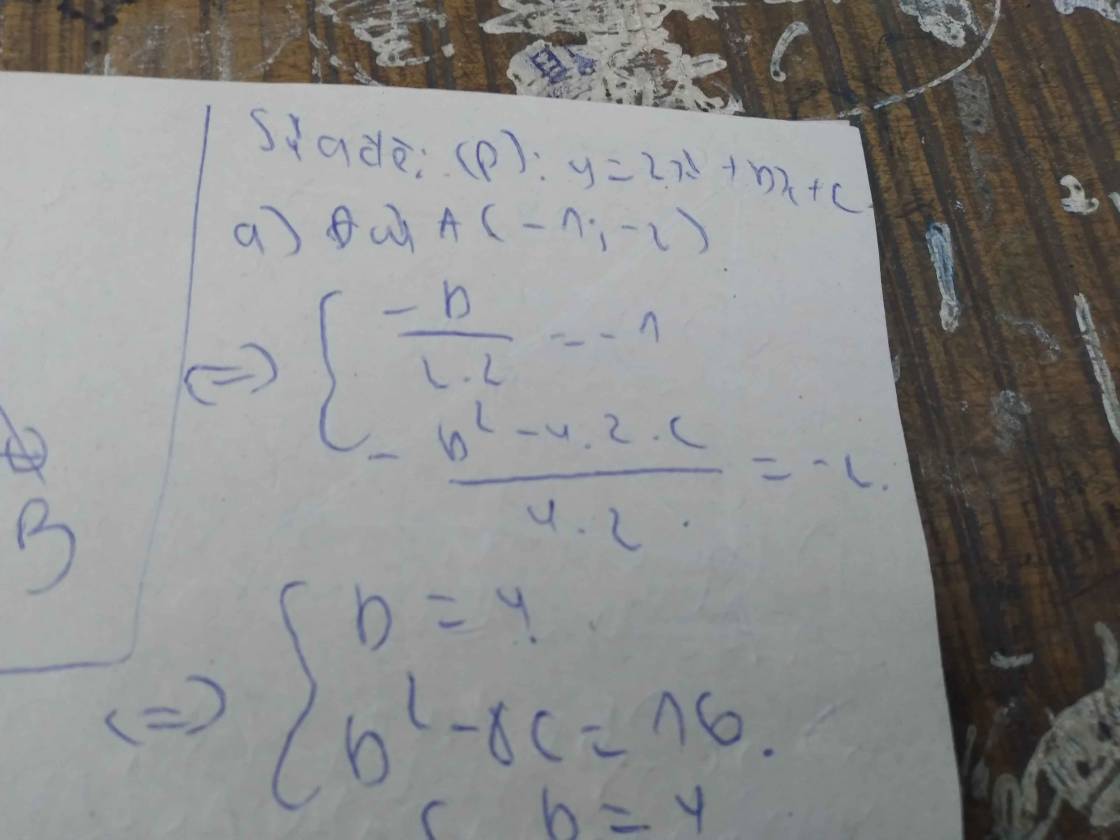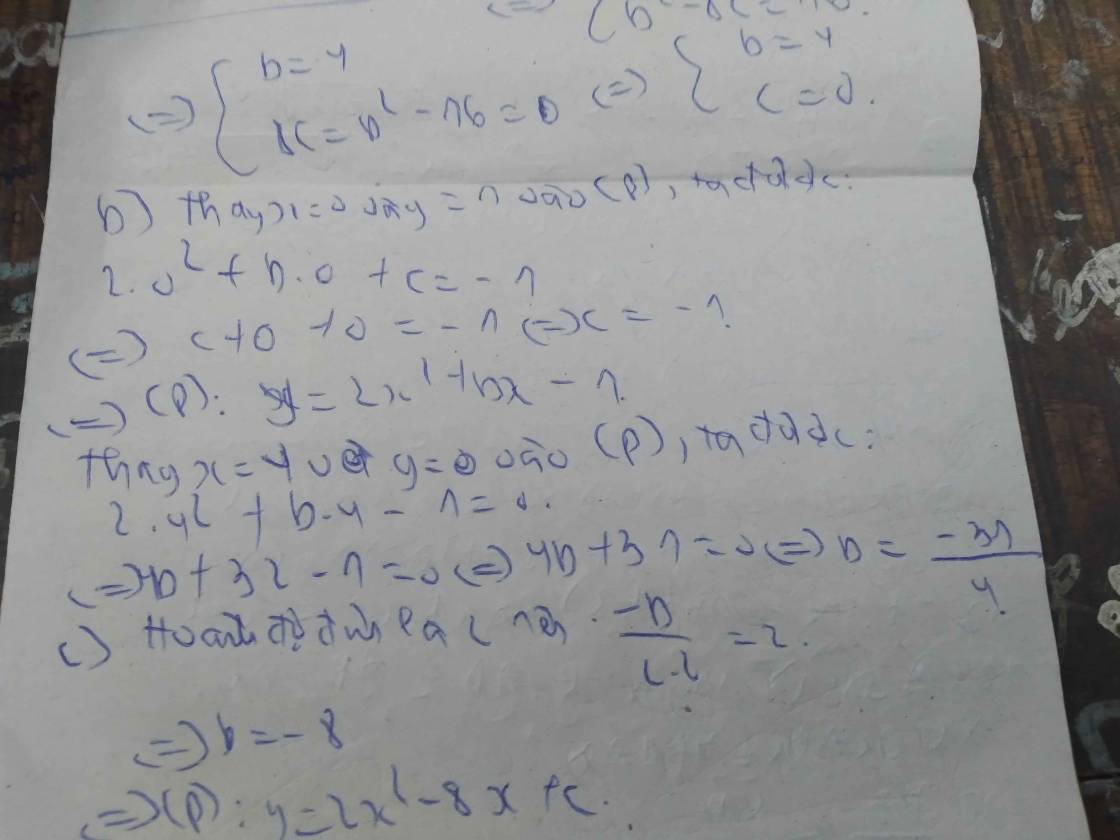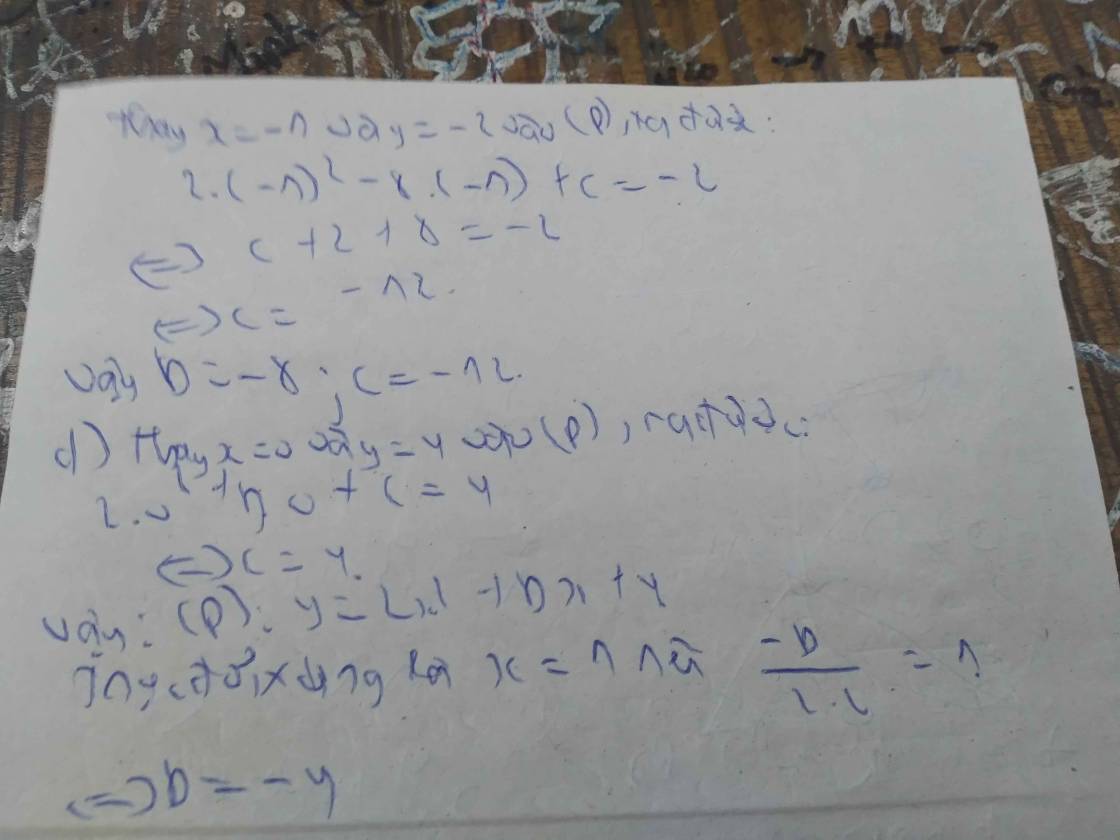Cho (P) : y= x^2 + bx+ c. Tìm các số b,c để đồ thị là một parabol thỏa:
a) Đỉnh A(1;2)
b) Đỉnh I(-3;1)
c) Đi qua điểm M(1;-1) và có hoành độ đỉnh bằng 4.
d) Đi qua M(1;2) và có hoành độ đỉnh là 2.
e) Đi qua A(3;3) và có trục đối xứng là đường thẳng x = 1.
Hãy nhập câu hỏi của bạn vào đây, nếu là tài khoản VIP, bạn sẽ được ưu tiên trả lời.


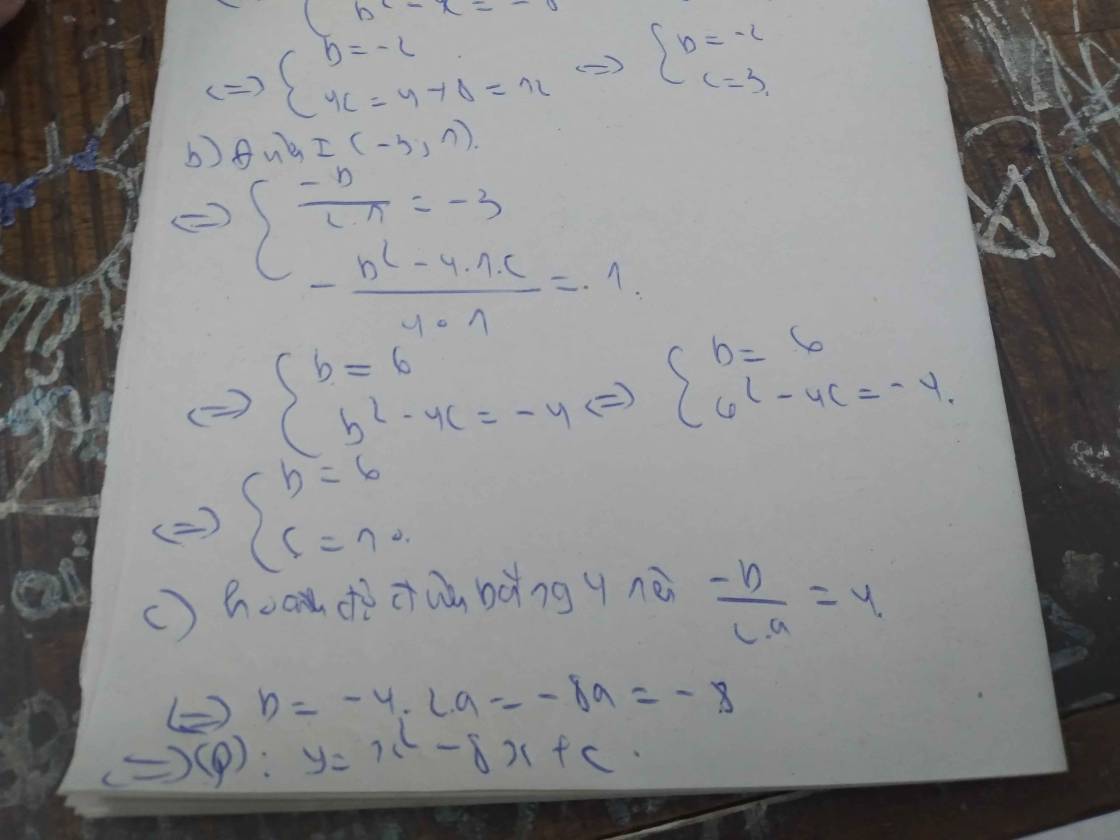

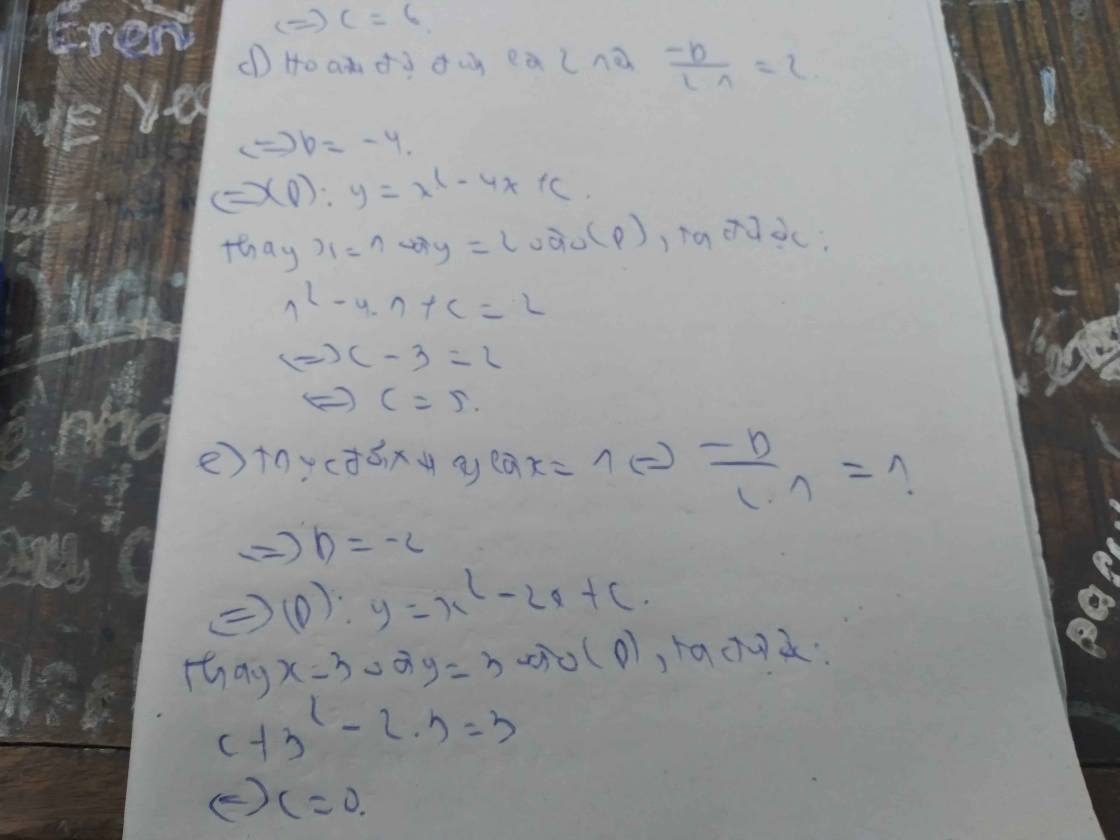

a: Vì (P) đi qua A(0;1); B(1;2); C(3;-1) nên ta có hệ phương trình:
\(\left\{{}\begin{matrix}a\cdot0^2+b\cdot0+c=1\\a\cdot1^2+b\cdot1+c=2\\a\cdot3^2+b\cdot3+c=-1\end{matrix}\right.\)
=>\(\left\{{}\begin{matrix}c=1\\a+b+1=2\\9a+3b+1=-1\end{matrix}\right.\Leftrightarrow\left\{{}\begin{matrix}c=1\\a+b=1\\9a+3b=-2\end{matrix}\right.\)
=>\(\left\{{}\begin{matrix}c=1\\9a+9b=9\\9a+3b=-2\end{matrix}\right.\Leftrightarrow\left\{{}\begin{matrix}c=1\\6b=11\\a+b=1\end{matrix}\right.\)
=>\(\left\{{}\begin{matrix}c=1\\b=\dfrac{11}{6}\\a=1-\dfrac{11}{6}=-\dfrac{5}{6}\end{matrix}\right.\)
b: Vì (P) đi qua M(0;-1); N(1;0) và P(2;3) nên ta có hệ phương trình:
\(\left\{{}\begin{matrix}a\cdot0^2+b\cdot0+c=-1\\a\cdot1^2+b\cdot1+c=0\\a\cdot2^2+b\cdot2+c=3\end{matrix}\right.\)
=>\(\left\{{}\begin{matrix}c=-1\\a+b-1=0\\4a+2b-1=3\end{matrix}\right.\Leftrightarrow\left\{{}\begin{matrix}c=-1\\a+b=1\\4a+2b=4\end{matrix}\right.\)
=>\(\left\{{}\begin{matrix}c=-1\\a+b=1\\2a+b=2\end{matrix}\right.\Leftrightarrow\left\{{}\begin{matrix}c=-1\\-a=-1\\a+b=1\end{matrix}\right.\Leftrightarrow\left\{{}\begin{matrix}c=-1\\a=1\\b=0\end{matrix}\right.\)
c: Vì (P) đi qua M(1;-2); N(0;4); P(2;1) nên ta có hệ phương trình:
\(\left\{{}\begin{matrix}a\cdot1^2+b\cdot1+c=-2\\a\cdot0^2+b\cdot0+c=4\\a\cdot2^2+b\cdot2+c=1\end{matrix}\right.\)
=>\(\left\{{}\begin{matrix}a+b+c=-2\\c=4\\4a+2b+c=1\end{matrix}\right.\Leftrightarrow\left\{{}\begin{matrix}c=4\\a+b=-2-c=-6\\4a+2b=1-4=-3\end{matrix}\right.\)
=>\(\left\{{}\begin{matrix}c=4\\4a+4b=-24\\4a+2b=-3\end{matrix}\right.\Leftrightarrow\left\{{}\begin{matrix}c=4\\2b=-21\\a+b=-6\end{matrix}\right.\)
=>\(\left\{{}\begin{matrix}c=4\\b=-\dfrac{21}{2}\\a=-6-b=-6+\dfrac{21}{2}=\dfrac{9}{2}\end{matrix}\right.\)
d: Hoành độ đỉnh là 2 nên -b/2a=2
=>b=-4a(1)
Thay x=3 và y=1 vào (P), ta được:
\(a\cdot3^2+b\cdot3+c=1\)
=>\(9a+3b+c=1\left(2\right)\)
Thay x=-1 và y=2 vào (P), ta được:
\(a\cdot\left(-1\right)^2+b\left(-1\right)+c=2\)
=>a-b+c=2(3)
Từ (1),(2),(3), ta có hệ phương trình:
\(\left\{{}\begin{matrix}b=-4a\\9a+3b+c=1\\a-b+c=2\end{matrix}\right.\Leftrightarrow\left\{{}\begin{matrix}b=-4a\\9a-12a+c=1\\a+4a+c=2\end{matrix}\right.\)
=>\(\left\{{}\begin{matrix}b=-4a\\-3a+c=1\\5a+c=2\end{matrix}\right.\Leftrightarrow\left\{{}\begin{matrix}b=-4a\\-8a=-1\\5a+c=2\end{matrix}\right.\)
=>\(\left\{{}\begin{matrix}a=\dfrac{1}{8}\\b=-4\cdot\dfrac{1}{8}=-\dfrac{1}{2}\\c=2-5a=2-\dfrac{5}{8}=\dfrac{11}{8}\end{matrix}\right.\)

a) Thay x=1 và y=-2 vào (P), ta được:
\(a\cdot1^2-4\cdot1+c=-2\)
\(\Leftrightarrow a-4+c=-2\)
hay a+c=-2+4=2
Thay x=2 và y=3 vào (P), ta được:
\(a\cdot2^2-4\cdot2+c=3\)
\(\Leftrightarrow4a-8+c=3\)
hay 4a+c=11
Ta có: \(\left\{{}\begin{matrix}a+c=2\\4a+c=11\end{matrix}\right.\)
\(\Leftrightarrow\left\{{}\begin{matrix}-3a=-9\\a+c=2\end{matrix}\right.\Leftrightarrow\left\{{}\begin{matrix}a=3\\c=2-a=2-3=-1\end{matrix}\right.\)
Vậy: (P): \(y=3x^2-4x-1\)

a: Thay x=-1 và y=2 vào (d), ta được:
\(-\left(m-2\right)+n=2\)
=>-m+2+n=2
=>-m+n=0
=>m-n=0(1)
Thay x=3 và y=-4 vào (d), ta được:
\(3\left(m-2\right)+n=-4\)
=>3m-6+n=-4
=>3m+n=2(2)
Từ (1) và (2) ta có hệ phương trình:
\(\left\{{}\begin{matrix}m-n=0\\3m+n=2\end{matrix}\right.\)
=>\(\left\{{}\begin{matrix}m-n+3m+n=2\\m-n=0\end{matrix}\right.\)
=>\(\left\{{}\begin{matrix}4m=2\\n=m\end{matrix}\right.\Leftrightarrow n=m=\dfrac{1}{2}\)
b: Thay x=0 và \(y=1-\sqrt{2}\) vào (d), ta được:
\(0\left(m-2\right)+n=1-\sqrt{2}\)
=>\(n=1-\sqrt{2}\)
Vậy: (d): \(y=\left(m-2\right)x+1-\sqrt{2}\)
Thay \(x=2+\sqrt{2}\) và y=0 vào (d), ta được:
\(\left(m-2\right)\cdot\left(2+\sqrt{2}\right)+1-\sqrt{2}=0\)
=>\(\left(m-2\right)\left(2+\sqrt{2}\right)=\sqrt{2}-1\)
=>\(m-2=\dfrac{\sqrt{2}-1}{2+\sqrt{2}}=\dfrac{-4+3\sqrt{2}}{2}\)
=>\(m=\dfrac{-4+3\sqrt{2}+4}{2}=\dfrac{3\sqrt{2}}{2}\)
c: 2y+x-3=0
=>2y=-x+3
=>\(y=-\dfrac{1}{2}x+\dfrac{3}{2}\)
Để (d) vuông góc với đường thẳng y=-1/2x+3/2 thì
\(-\dfrac{1}{2}\left(m-2\right)=-1\)
=>m-2=2
=>m=4
Vậy: (d): \(y=\left(4-2\right)x+n=2x+n\)
Thay x=1 và y=3 vào y=2x+n, ta được:
\(n+2\cdot1=3\)
=>n+2=3
=>n=1
d: 3x+2y=1
=>\(2y=-3x+1\)
=>\(y=-\dfrac{3}{2}x+\dfrac{1}{2}\)
Để (d) song song với đường thẳng \(y=-\dfrac{3}{2}x+\dfrac{1}{2}\) thì
\(\left\{{}\begin{matrix}m-2=-\dfrac{3}{2}\\n\ne\dfrac{1}{2}\end{matrix}\right.\)
=>\(\left\{{}\begin{matrix}m=\dfrac{1}{2}\\n\ne\dfrac{1}{2}\end{matrix}\right.\)
Vậy: (d): \(y=\left(\dfrac{1}{2}-2\right)x+n=-\dfrac{3}{2}x+n\)
Thay x=1 và y=2 vào (d), ta được:
\(n-\dfrac{3}{2}=2\)
=>\(n=2+\dfrac{3}{2}=\dfrac{7}{2}\left(nhận\right)\)

a: \(\left\{{}\begin{matrix}x_I=\dfrac{3}{2\cdot1}=\dfrac{3}{2}\\y_I=-\dfrac{\left(-3\right)^2-4\cdot1\cdot\left(-2\right)}{4\cdot1}=-\dfrac{17}{4}\end{matrix}\right.\)

a) Parabol: \(y = a{(x - h)^2} + k\) với \(I(h;k) = \left( {\frac{5}{2}; - \frac{1}{4}} \right)\) là tọa độ đỉnh.
\( \Rightarrow y = a{\left( {x - \frac{5}{2}} \right)^2} - \frac{1}{4}\)
(P) đi qua \(A(1;2)\) nên \(2 = a{\left( {1 - \frac{5}{2}} \right)^2} - \frac{1}{4} \Rightarrow a = 1\)
\( \Rightarrow y = {\left( {x - \frac{5}{2}} \right)^2} - \frac{1}{4} \Leftrightarrow y = {x^2} - 5x + 6\)
Vậy parabol đó là \(y = {x^2} - 5x + 6\)
b) Vẽ parabol \(y = {x^2} - 5x + 6\)
+ Đỉnh \(I\left( {\frac{5}{2}; - \frac{1}{4}} \right)\)
+ Giao với Oy tại điểm \((0;6)\)
+ Giao với Ox tại điểm \((3;0)\) và \((2;0)\)
+ Trục đối xứng \(x = \frac{5}{2}\). Điểm đối xứng với điểm \((0;6)\) qua trục đối xứng có tọa độ \((5;6)\)
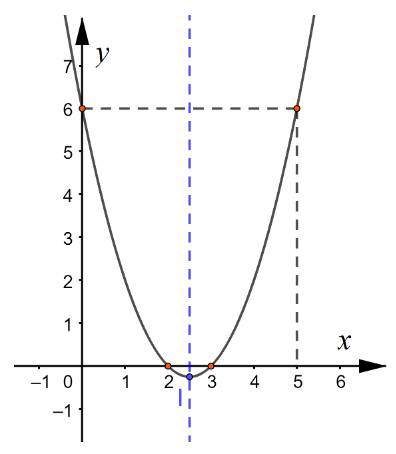
b) Hàm số đồng biến trên khoảng \(\left( { - \frac{5}{2}; + \infty } \right)\)
Hàm số nghịch biến trên khoảng \(\left( { - \infty ; - \frac{5}{2}} \right)\)
c) \(f(x) \ge 0 \Leftrightarrow {x^2} - 5x + 6 \ge 0\)
Cách 1: Quan sát đồ thị, ta thấy các điểm có\(y \ge 0\) ứng với hoành độ \(x \in ( - \infty ;2] \cup [3; + \infty )\)
Do đó tập nghiệm của BPT \(f(x) \ge 0\) là \(S = ( - \infty ;2] \cup [3; + \infty )\)
Cách 2:
\(\begin{array}{l} \Leftrightarrow {x^2} - 5x + 6 \ge 0\\ \Leftrightarrow (x - 2)(x - 3) \ge 0\end{array}\)
Do đó \(x - 2\) và \(x - 3\) cùng dấu. Mà \(x - 2 > x - 3\;\forall x \in \mathbb{R}\)
\( \Leftrightarrow \left[ \begin{array}{l}x - 3 \ge 0\\x - 2 \le 0\end{array} \right. \Leftrightarrow \left[ \begin{array}{l}x \ge 3\\x \le 2\end{array} \right.\)
Tập nghiệm của BPT là \(S = ( - \infty ;2] \cup [3; + \infty )\)

2
a)
d đi qua A (1;2), B(2;5)
=> Ta có hệ phương trình: \(\left\{{}\begin{matrix}\left(m-1\right).1+n=2\\\left(m-1\right).2+n=5\end{matrix}\right.\)
\(\Leftrightarrow\left\{{}\begin{matrix}m+n=3\\2m+n=7\end{matrix}\right.\Leftrightarrow\left\{{}\begin{matrix}m=4\\n=-1\end{matrix}\right.\)
b)
d có hệ số góc a = 3 => d: y = 3x + n
=> m -1 = 3 <=> m = 4
d cắt Ox tại x = -2, y = 0 \(\Leftrightarrow0=3.\left(-2\right)+n\) => n = 6
c)
d trùng d' \(\Rightarrow\left\{{}\begin{matrix}m-1=5\\n=-3\end{matrix}\right.\Rightarrow\left\{{}\begin{matrix}m=6\\n=-3\end{matrix}\right.\)

